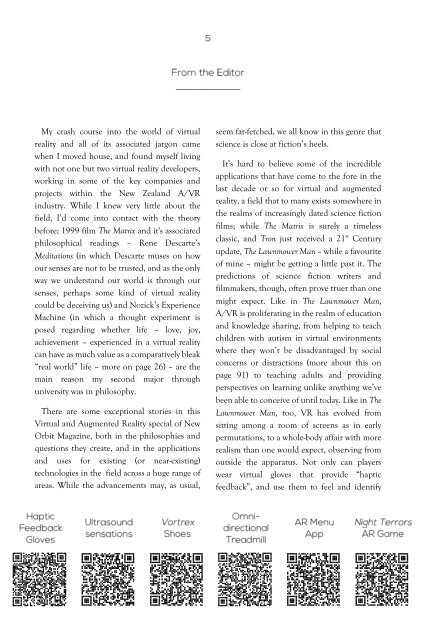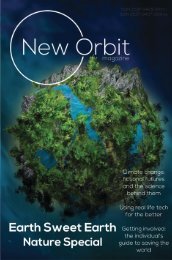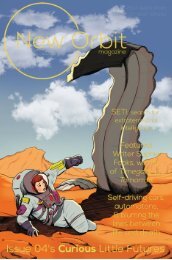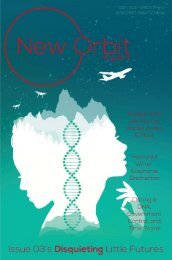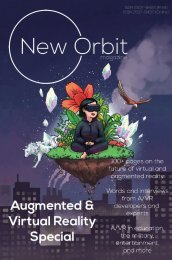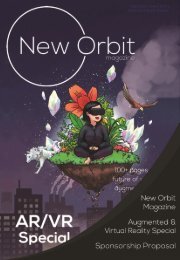New Orbit Magazine Online: Issue 02, February 2018 - AR/VR Special
You also want an ePaper? Increase the reach of your titles
YUMPU automatically turns print PDFs into web optimized ePapers that Google loves.
_____________<br />
My crash course into the world of virtual<br />
reality and all of its associated jargon came<br />
when I moved house, and found myself living<br />
with not one but two virtual reality developers,<br />
working in some of the key companies and<br />
projects within the <strong>New</strong> Zealand A/<strong>VR</strong><br />
industry. While I knew very little about the<br />
field, I’d come into contact with the theory<br />
before; 1999 film The Matrix and it's associated<br />
philosophical readings – Rene Descarte’s<br />
Meditations (in which Descarte muses on how<br />
our senses are not to be trusted, and as the only<br />
way we understand our world is through our<br />
senses, perhaps some kind of virtual reality<br />
could be deceiving us) and Nozick’s Experience<br />
Machine (in which a thought experiment is<br />
posed regarding whether life – love, joy,<br />
achievement – experienced in a virtual reality<br />
can have as much value as a comparatively bleak<br />
“real world” life – more on page 26) – are the<br />
main reason my second major through<br />
university was in philosophy.<br />
There are some exceptional stories in this<br />
Virtual and Augmented Reality special of <strong>New</strong><br />
<strong>Orbit</strong> <strong>Magazine</strong>, both in the philosophies and<br />
questions they create, and in the applications<br />
and uses for existing (or near-existing)<br />
technologies in the field across a huge range of<br />
areas. While the advancements may, as usual,<br />
seem far-fetched, we all know in this genre that<br />
science is close at fiction’s heels.<br />
It’s hard to believe some of the incredible<br />
applications that have come to the fore in the<br />
last decade or so for virtual and augmented<br />
reality, a field that to many exists somewhere in<br />
the realms of increasingly dated science fiction<br />
films; while The Matrix is surely a timeless<br />
classic, and Tron just received a 21 st Century<br />
update, The Lawnmower Man – while a favourite<br />
of mine – might be getting a little past it. The<br />
predictions of science fiction writers and<br />
filmmakers, though, often prove truer than one<br />
might expect. Like in The Lawnmower Man,<br />
A/<strong>VR</strong> is proliferating in the realm of education<br />
and knowledge sharing, from helping to teach<br />
children with autism in virtual environments<br />
where they won’t be disadvantaged by social<br />
concerns or distractions (more about this on<br />
page 91) to teaching adults and providing<br />
perspectives on learning unlike anything we’ve<br />
been able to conceive of until today. Like in The<br />
Lawnmower Man, too, <strong>VR</strong> has evolved from<br />
sitting among a room of screens as in early<br />
permutations, to a whole-body affair with more<br />
realism than one would expect, observing from<br />
outside the apparatus. Not only can players<br />
wear virtual gloves that provide “haptic<br />
feedback”, and use them to feel and identify


